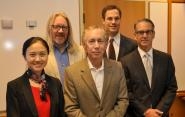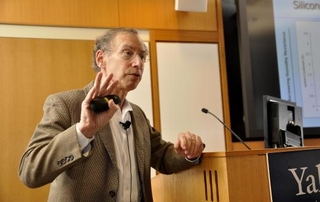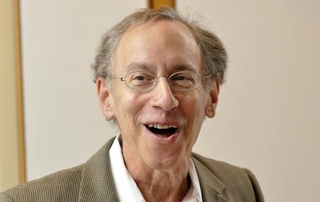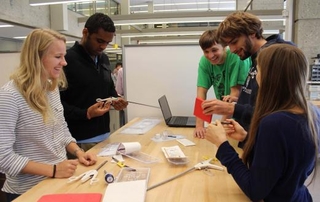Creating Opportunities for Medical Device Innovation

“There’s very little that’s not possible, and I want people to realize that,” Robert Langer said, summarizing his September 19 presentation at Yale. In his lecture, Langer supported that claim with a stream of examples drawn from his impressive career in innovation—a career that has resulted in over 220 major awards, produced nearly 1,050 patents worldwide, earned an honorary degree from Yale, and made Langer, an Institute Professor at MIT(link is external), the most cited engineer in history.

“There’s very little that’s not possible, and I want people to realize that,” Robert Langer said, summarizing his September 19 presentation at Yale. In his lecture, Langer supported that claim with a stream of examples drawn from his impressive career in innovation—a career that has resulted in over 220 major awards, produced nearly 1,050 patents worldwide, earned an honorary degree from Yale, and made Langer, an Institute Professor at MIT(link is external), the most cited engineer in history.

Inspiring a Community
Langer’s presentation offered a firsthand look into his lab’s process for developing novel inventions, which have included polymers for transporting macromolecules into the human body, an implantable chip for long-term regulated drug release, materials for artificial arteries, and even a line of anti-frizz haircare products. Langer turned these “platform technologies”—inventions that can be reused for multiple applications—into companies by first describing the innovations in high-profile journals, then characterizing the unique features of each technology in patents that, according to Langer, not only provide the freedom to operate but also crucially prevent competitors from developing similar inventions.
That’s a process to aspire to, says Mark Saltzman, Goizueta Foundation Professor and chair of the Department of Biomedical Engineering and also a co-founder of CBIT. As a former student of Langer’s, Saltzman was excited to see Langer’s presentation inspire the many Yale community members in attendance. “Bob is an incredibly prolific academic entrepreneur,” said Saltzman. “His talk got people energized to follow in his footsteps, and that’s exactly what CBIT works to accomplish.”
Some of that effect can be attributed to Langer’s passionate descriptions of his students in his talk—especially those students who now work at Yale, including Saltzman, who worked with Langer on the brain tumor therapy called Gliadel; professor of anesthesiology & biomedical engineering Laura Niklason, who founded Humacyte, a company that creates human tissue replacements; and CBIT Executive Director Christopher Loose, who founded Semprus Biosciences, a company specializing in bacterial barriers for medical device implants.
“Every time I’ve formed a company, I did it with my students, and I did it because they wanted to do it,” Langer said. “But what I could not have realized is that if you work with people who have spent four, five, or six years of their life doing a thesis or postdoctoral work on a project, they will then walk through walls at this new company—even compared to somebody with thirty to forty years of [business] experience. Having these students who are so dedicated, so personally invested, has been critical to success. I’d trade passion for experience almost all the time.”
Passion is in fact one reason CBIT wanted to bring Langer to campus, according to Loose. “Having someone like Bob Langer come to campus is a tremendous boon for the community,” said Loose. “He inspires people to think about big, unmet clinical needs, and in turn, I hope we’ll see those same people committing themselves to creating solutions that address those needs.”

Developing Prototypes
CBIT’s next major event, a “healthcare hackathon” that begins Oct. 10, will actively address clinical needs—and it will do so very quickly. Called “Hacking Health @ Yale(link is external),” this hackathon brings together clinicians, engineers, and entrepreneurs to tackle the challenges of healthcare innovation in teams: clinicians will bring the challenges they’ve identified in their practice; engineers will bring their design and fabrication skills to address those challenges; and entrepreneurs will bring the business acumen needed to realize those solutions on a large scale. Together, they’ll see what can be accomplished in a weekend.
And the emphasis is on together. “Among CBIT’s highest priorities,” said CBIT Engineering Director Jean Zheng, “is to continually forge new connections between the School of Engineering & Applied Science, Yale School of Medicine, and the School of Management. Medical device development can only happen when all three of these key pieces are in place.”
To that end, the healthcare hackathon will take place at three locations: beginning at 6 p.m. on Friday, Oct. 10, the official kick-off, introductions, keynote speeches, and clinician pitches will be held at Yale School of Medicine’s TAC Auditorium; at 10 a.m. on Saturday, Oct. 11, teams will convene at the School of Engineering & Applied Science’s (SEAS) Davies Auditorium to address problems put forth by clinicians and hackathon participants; finally, at 1 p.m. on Sunday, Oct. 12, teams will pitch their solutions at the Yale School of Management’s Evans Hall (see the Hacking Health event page for directions(link is external) and the full schedule(link is external)).
“For the hackathon, we want to break down the barrier that says ‘innovation is hard,’ ” said Zheng. “We’re getting clinicians, engineers, designers, and business people all together in one location to prototype viable medical devices over a single weekend. Devices that come out of the hackathon might not be ready for large-scale deployment, but they’ll be real accomplishments that could move forward towards further refinement.”
The hackathon—which has some similarities to the “Medical Device Design & Innovation,” another SEAS-CBIT collaboration that we’ve reported on before(link is external)—is just one of three opportunities this fall for such collaborative creativity, with two more “Physician Pitch Nights” planned in the next two months; in contrast to the hackathon, the pitch nights are specific avenues for clinicians at Yale School of Medicine to pitch medical device ideas in the hope of attracting teams from the Yale community to help carry that idea further.
Through both their design events and their guest speakers, CBIT is ultimately establishing a culture of medical device development that complements the work already being done at the Center for Engineering Innovation & Design(CEID) and at the Yale Entrepreneurial Institute. “Our function is to build a network to identify unmet clinical needs and to catalyze team formation in education across schools at Yale, within the CEID, and at the University of Connecticut,” said Dr. Peter Schulam, chair of the Department of Urology at Yale School of Medicine, chief of urology at Yale-New Haven Hospital, and co-founder of CBIT.
And for Saltzman, that culture of medical device development is a natural outgrowth of the culture of engineering at SEAS. “If you’re going to create new technologies for medicine, you need people who understand and develop new technologies,” says Saltzman. “And that’s what engineers bring to the table.”